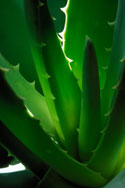
Photo © Steven Foster
Introduction
Aloe can be found throughout the tropics and warmer regions worldwide. Because of this global naturalization, its true origin is unknown. It is thought to have come from North Africa or the Nile region in Sudan.1 The genus contains at least 324 species of herbs, shrubs, and trees, primarily African, with some in Madagascar and the Arabian Peninsula.2 The commercially significant aloes are perennials, with 15 to 30 fleshy leaves up to 1.5 feet long and 4 inches across the base. Saw-teeth mark the margins of the leaves.1 History and Cultural Significance
Aloe has played a significant medicinal role for thousands of years. Egyptians, Assyrians, and Mediterranean peoples used the dried latex (from cells inside the leaves) and the gel.3 In Egypt, aloe was called “the plant of immortality” and was given as an offering at the funerals of pharaohs and used in the baths of Egyptian queens Nefertiti and Cleopatra. According to the Roman scholar, Pliny, the plant was also used for embalming. In the first century C.E., the Greek physician Dioscorides used aloe for soothing, sores and wounds. In the 10th century aloe was used in England, and during the 17th century records show that the East India Company frequently purchased aloe from the king of Socotra. Today, Egyptians still hang an aloe plant over the door of a new house to provide a long and fruitful life for its occupants. In China, Mexico, and the West Indies, it has become a household remedy for a variety of uses. Externally, aloe gel has been used in many ways, including to alleviate skin irritation.3 In cosmetics, the gel is added to moisturizers, cleansers, shampoos, suntan lotions, and sunburn treatments. Modern Research
The research into aloe continues for a variety of practical, medicinal uses. One study in 2003 evaluated the use of aloe vera gel gloves for treatment of dry skin associated with occupational exposure.4 Current research is being performed on the external uses of aloe gel for its possible anti-inflammatory effects, intranasal use for allergies, and painful dry socket treatment as a result of dental procedure complications.5,6,7,8 Other studies on the external uses of aloe include the application of an aloe gel to treat burns and the potential use of the gel as a topical antimicrobial.9,10 Future Outlook
Aloe is currently being grown and harvested worldwide. It grows in most of Africa, southern Arabia, the Caribbean, Japan, Madagascar, the Mediterranean, and North and South America.11 It is extensively commercially produced and cultivated allowing a constant supply to be available at all times. References
1 Grindlay D., Reynolds T. The aloe vera phenomenon: a review of the properties and modern uses of the leaf parenchymagel. Journal of Ethnopharmacology. 1986;16:117-151. 2 Crosswhite F, Crosswhite C. Aloe vera, plant symbolism and the threshing floor: light, life and good in our heritage. Desert Plants. 1984;6:43-50. 3 Goldberg A. Aloe: Aloe spp. Botanical Booklet Series #315. Austin, TX: American Botanical Council; 1999. 4 West DP, Zhu YF. Evaluation of aloe vera gel gloves in the treatment of dry skin associated with occupational exposure. Am J Infect Control. 2003 Feb;31(1):40-2. 5 Bautista-Perez R, Segura-Cobos D, Vasquez-Cruz B. In vitro antibradykinin activity of Aloe barbadensis gel. J Ethnopharmacol. July 2004;93(1):89-92. 6 Avijgan M. Phytotherapy: an alternative treatment for non-healing ulcers. J Wound Care. April 2004;13(4):157-158. 7 Yu H, Dong Z, Yang Z. Molecular biological study of aloe vera in the treatment of experimental allergic rhinitis in rat. Lin Chuang Er Bi Yan Hou Ke Za Zhi. May 2002;16(5):229-231. 8 Poor MR, Hall JE, Poor AS. Reduction in the incidence of alveolar osteitis in patients treated with the SaliCept patch, containing Acemannan hydrogel. J Oral Maxillofac Surg. April 2002;60(4):374-379. 9 Duansak D, Somboonwong J, Patumraj S. Effects of Aloe vera on leukocyte adhesion and TNF-alpha and IL-6 levels in burn wounded rats. Clin Hemorheol Microcirc. 2003;29(3-4):239-246. 10 Barrantes E, Guinea M. Inhibition of collagenase and metalloproteinases by aloins and aloe gel. Life Sci. January 3, 2003;72(7):843-850. 11 DerMarderosian A, Beutler JA, eds. The Review of Natural Products: The Most Complete Source of Natural Product Information. 3rd edition. St. Louis, MO: Facts and Comparisons, 2002.
|